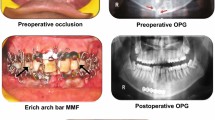Abstract
Purpose
The management of paediatric mandibular fractures using an acrylic splint is a time-tested procedure. Traditionally, an awl is used to place wires to secure such splints. In this article, we have designed prospective study to compare a new technique of using intravenous cannula stillete (IVCS) as against conventional awl in placement of the circummandibular wires.
Methods
A total of 45 patients were included in the study. Group I included 22 subjects in whom an awl was used, and group II included 23 subjects in whom IVCS was used for placement of circummandibular wires. Parameters such as post-operative pain, swelling and ease of penetration, size of entry and exit wound and injury to adjacent structures were compared.
Results
Statistically significant reduction in post-operative pain and swelling were noticed in groupie. The operating surgeons experienced greater ease in using IVCS, and the size of the entry and exit wounds were also relatively small as compared to using an awl.
Conclusion
The IVCS, which is disposable, having finer diameter, a sharp bevel and internal wire carrying capacity, clearly demonstrates statistically significant advantages over the usage of a conventional awl.





Similar content being viewed by others
References
Demianczuk AN, Verchere C, Phillips JH (1999) The effect on facial growth of paediatric mandibular fractures. J Craniofac Surg 10(4):323–328
Eppley BL (2005) Use of resorbable plates and screws in paediatric facial fractures. J Oral Maxillofac Surg 63:385–391
Graham GG, Peltier JR (1960) The management of mandibular fractures in children. J Oral Surg 18:416–423
Lida S, Matsuya T (2002) Paediatric maxillofacial fractures: their aetiological characters and fracture patterns. J Craniomaxillofac Surg 30(4):237–241
James D (1985) Maxillofacial injuries in children. In: Rowes NL, Jl W (eds) Maxillofacial injuries, 1st edn. Edinburgh, Churchill Livingstone, pp 538–558
Kaban LB (2004) Facial trauma II: dentoalveolar injuries and mandibular fractures. In: Kaban LB (ed) Paediatric oral and maxillofacial surgery, 1st edn. Saunders, Philadelphia, pp 441–462
Rudolf RM (2005) Treatment of paediatric facial fractures—the case for metallic fixation. J Oral Maxillofac Surg 63:382–384
Senel FC, Tekin US, Imamoglu M, Trabzon, Kirikkale (2006) Treatment of mandibular fractures with bioresorbable plates in an infant: report of a case. Oral Surg Oral Med Oral Path Oral Radiol Endod 101:448–450
Thomas S, Yuvaraj V (2010) Atraumatic placement of circummandibular wires: a technical note. Int J Oral Maxillofac Surg 39(1):83–85
Tanaka N et al (1993) Maxillofacial fractures in children. J Craniofac Surg 21(7):289–293
Zimmermann CE, Troulis MJ, kaban LB (2006) Paediatric facial fractures: recent advances in prevention, diagnosis amd management. Int J Oral Maxillofac Surg 35:2–13
Author information
Authors and Affiliations
Corresponding author
Rights and permissions
About this article
Cite this article
Vaithilingam, Y., Thomas, S., Singh, D. et al. Awl versus intravenous cannula stillete in circummandibular wiring—a prospective comparative study. Oral Maxillofac Surg 15, 21–25 (2011). https://doi.org/10.1007/s10006-010-0228-7
Published:
Issue Date:
DOI: https://doi.org/10.1007/s10006-010-0228-7




